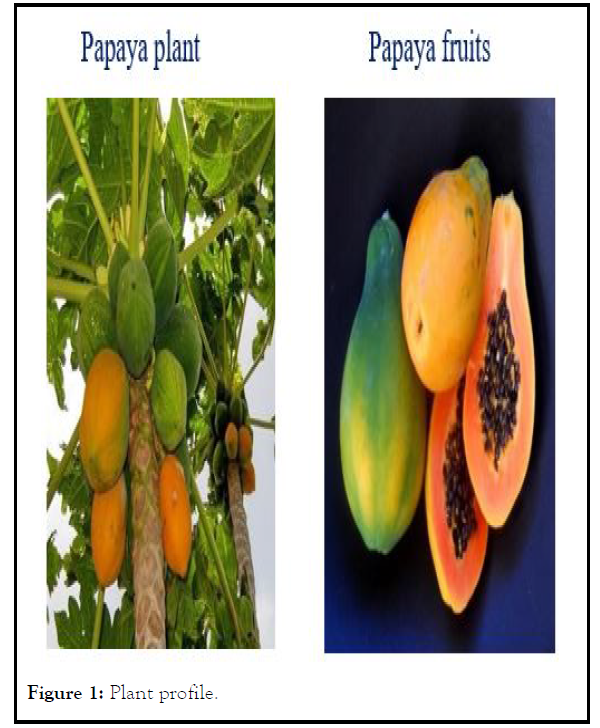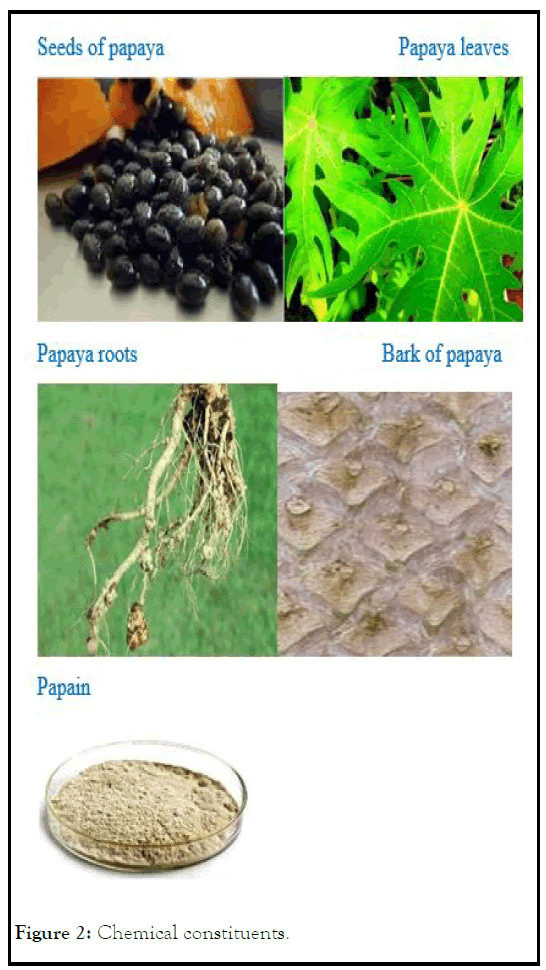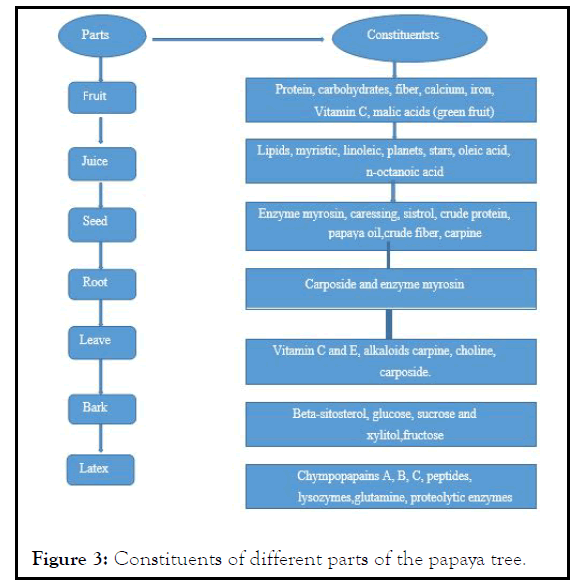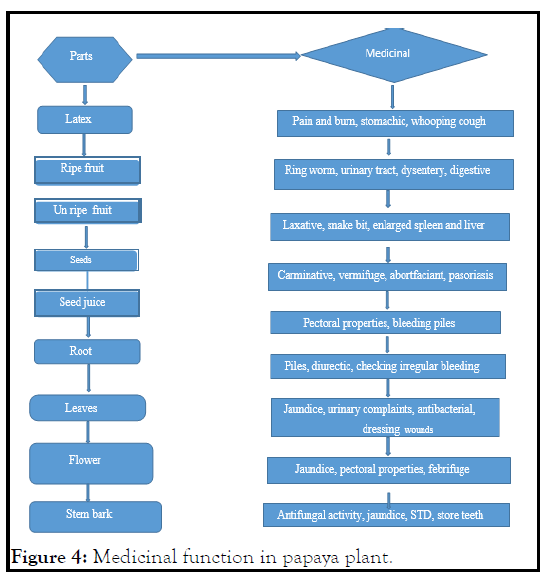Journal of Horticulture
Open Access
ISSN: 2376-0354
ISSN: 2376-0354
Review Article - (2023)Volume 10, Issue 1
Carica papaya Linn is commonly called as pawpaw and belongs to family Caricaceae. A well-known popularly fruit worldwide consumed for its food and its nutritional values. In traditional system of medicine papaya fruit properties and other parts of plants are also known. Worldwide as a processed product and fresh fruit and vegetable it is consumed. Papaya fruit is healthy and delicious and it consists medicinal properties to the whole plant parts such as fruit, bark, seeds, peel, pulp, roots consists active substances which are biologically important its application in pharmaceutical industry. Due to high content of proteolytic enzymes which are predominantly isolated like chymopapain and papain which have antibacterial, antiviral, antifungal properties and it also owed with many benefits and high content of vitamin A, B, C, iron and fiber, thiamine. Papaya latex consists of papain which is beneficial to human digestive system it has natural digestive properties and it is considered valuable nutraceutical fruit plant and multi-faceted plant. From the fruit of papaya primarily obtained papain enzyme commercially used in chewing gum industry and for natural silk-degumming In this review it has been much studied wide applications in food and pharmaceutical industry and also nutritional value of fruits.
Carica papaya; Food industry; Medicinal plant; Multi-faceted plant nutraceuticals; Pharmacological properties
Papaya (Carica papaya L) belongs to Caricaceae family. In English it is commonly called as pawpaw, and in Sanskrit is called as Erandakarkati and in Hindi it is called as Papita. In tropical countries like India, SriLanka, Malaysia, Philippines [1]. As a dessert and fresh fruit ripe papaya is consumed and into fresh salads unripe green papaya is added. From unripe green papaya fruit latex an important bioactive substances papain is recovered. Throughout the year papaya is available it acts as a powerhouse of nutrients. Papaya has rich source of vitamin A, vitamin C, vitamin E three antioxidants which are powerful [2]. Fiber, folate, potassium, magnesium are minerals found in it. Using seeds in home gardens planted the plant fairly it easy to grow. All year around it constantly bears fruits after sowing seeds about 9 months-12 months approximately fruit can be harvested. Papaya plant shows palmate-shaped large leaves bearing a single stem crown, and it is polygamous and herbaceous plant. Near leaf petiole at leaf axils the flowers are produced [3]. About 7 m-8 m tall high it grows and about 20 cm in diameter its trunk varies [4]. In a year it can be grown about 12 feet because they are fast growing. It ranges from 125,000 lbs to 300,000 lbs per hac. Yearly production commercially plants at a density of 1500 plants-2500 plants per hac they grown. From 1 years-2 years harvesting is done when tree becomes for proper reaping [5]. Roots, leaves, latex, seeds, fruits are the plant parts that have used. A few plant parts are known to be antibacterial, laxative, digestive, cardiotonic, analgesic, stomachic [6]. Papain a digestive enzyme it contains that treats effectively sports injuries, trauma, and allergies and also nutrients prevent colon cancer, improves cardiovascular system, strokes, and heart diseases. Below grape fruit and above strawberry it ranks from total production [7]. India, Mexico and Brazil are major papaya producer. In United States primary papaya producer is Hawaii, about 66% of fresh production it is exported to Japan and to US mainland primarily [8]. In all living organisms for metabolic pathways governing in our life key elements enzymes are very important. In addition in industrial and agricultural applications they play great roles nowadays. In pharmaceutical, food, feed, bio refinery industries they are used widely due to its wide range of bio catalytic properties. For more efficient antibiotics development they acts as important biocatalysts for bioactive production through using enzymes. In different applications they serve worldwide in many industries. Protease enzymes are used due to its wide range catalytic properties. Cysteine proteases among these also known as thiol enzymes or protease enzymes which helps in protein structure break down and degrading it’s primarily function. Immerse biological value it possess and in every viruses, bacteria and eukaryotes virtually they found. Currently it has listed out super families about fourteen cysteine proteases this protease systematic classification has done by MEROPS where others to be assigned yet. The one with plant origin especially from other different super-families. Latex extract which consist cysteine endopeptidase obtained from Carica papaya tropical plant where peptidase enzyme is a mixture such as papaya endopeptidase 3,4, papain enzyme, A and B chymopapain, caricain which are about 80% more constitutes its enzyme fractions considers as having highest significance commercially in different industries due to various applications. In structural view point of enzyme papain have most regards in extensive characterization of kinetic data. For cysteine proteases super family in current main source empirical data. In plant kingdom widely distributed cysteine protease related and papain enzyme acts primarily as defense factors for hosts and pathogens. Papain has purified and it is extensively studied in despite and about 8% peptidase it consists.
Plant profile
Common name, taxonomical classification and parts used: In the world wide it has four genera, to a small Caricaceae family papaya belongs. In India it is best known species by four species Carica Linn genus is represented and it is widely distributed. The taxonomical classification includes kingdom (plantae), order (Brassicales), family (Caricaceae), genus (Carica), and species (Carica papaya).
It includes common names like Pawpaw, Papaya, Papaw, Papita, Arand-kharpuja, Papaia, and Papaya Baum.
The parts used contain fruit, leaves, bark (Figure 1).

Figure 1: Plant profile.
Chemical constituents: Papaya consists of different parts and it consists of various chemical constituents in seeds, fruits, leaves, fruit juice, bark and latex which are shown as follows:
Fruit: Consists of minerals like iron, calcium, thiamine, vitamin C, riboflavin, niacin, and malic acids (green fruits) and also consists of fat, proteins and carbohydrates. Volatile compounds: such as carpaine cis and trans, benzylisothiocynate, alkaloids.
Juice: Oleic acid, linoleic acid, linolenic acid, myristic acid.
Seed: Caricin, papaya oil, fatty acids, crude protein, crude fiber, and an enzyme myrosin.
Root: An enzyme myrosin and carposides.
Leaves: Vitamin C, E, carposide and alkaloids such as carpain, pseudo carpain choline.
Bark: Fructose, glucose, xylitol, beta-sitosterol.
Latex: Chemopapain, papain, peptidase A and B, lysozymes (Figure 2).

Figure 2: Chemical constituents.
Constituents of different parts of the papaya tree: Chymopapain and papain are two potent active compounds biochemically found in papaya which are known to aid digestion. It is employed in treating arthritis, dyspepsia and other digestive disorders, and over a wide pH range it is active for reducing enlarged tonsils and in liquid form it is prepared and it reduces human urine acidity. Chymopapain has been, of lately, by the Food and Drug Administration (FDA) for intradiscal injection in patients with documented herniated lumbar inter vertebral discs. For asthma relief leaves of papaya are smoked and for elephantoid growth and nervous pains its leaves poultice have been administered. On heart an alkaloid which is active better is carpine found in young leaves (Figure 3).

Figure 3: Constituents of different parts of the papaya tree.
Nutritional value of 100 g of papaya fruit
Ripe papaya contain different constituents: Energy (163 kj), protein (0.6 g), fat (0.1 g), minerals (0.5 g), fiber (0.8 g), carbohydrates (7.2 g), beta-carotene (888 μm), total carotene (2 740 μm), sodium (3 mg), iron (0.10 g), vitamin A (1 094 IU), vitamin E (0.73 mg), niacin (3 mg) and water (89%). Papaya is rich in many nutritional values and it, flavonoids, carbohydrates, alkaloids.
Medicinal and pharmacological properties of papaya: Various pharmacological actions and medicinal uses of different parts of the papaya has various different parts with various medicinal and pharmacological actions with different fractions which are reported with the crude extracts from different parts of papaya and for treatment of various diseases they used as traditional medicine.
From different parts of papaya tree (latex, seed, leaf, root, stem, bark and fruit) many phytochemicals which are biochemically active have been studied for potency and isolated from papaya. Antifungal chitinase from papaya fruit which is genetically cloned and obtained from fruit and it has been characterized and also it exhibits antibacterial activity class IV chitinase based on amino acid sequence. From fruits of papaya it is available commercially spray dried latex immunological properties it exhibit and it has isolatable chamopapain [9]. In Spanish town in few hospitals as tropical ulcer dressing fruits of papaya are used, in the West Indies in university and in kingston public hospital, Jamara. Papaya enhances desloughing by its dressing preparation. It is very much important which is available widely and economical in few hospitals it is used as burn dressing which is tolerable by children, in papaya plant parts of papaya there is medicinal function (Figure 4) [10].

Figure 4: Medicinal function in papaya plant.
Antioxidant activity: Pawpaw green fruits methanolic extract includes Glutathione Peroxidase (GPx) to know its effect on antioxidant enzymes in vivo it was evaluated. There is significant increase in the activities glutathione reductase, GST, GPx, glucose-6-phosphate dehydrogenase due to the ethyl acetate fraction. It was suggested that quercetin and β-sitosterol may be responsible for the antioxidant potential.
Wound healing activity: Pawpaw aqueous fruit extract is used for wound healing and it has 100 mg/(kg.d) for 10 d and it was suggested that it has potent wound healing property, aqueous extract shows wound area reduction about 77% when compared to 59% contraction to wound of the controls.
Antimicrobial activity: Roots and leaves of aqueous extract of pawpaw show antimicrobial activity at different concentrations (25 mg/mL, 50 mg/mL, 100 mg/mL, and 200 mg/mL). By using agar diffusion method against some human pathogenic bacteria.
Antifungal activity: Fluconazole and latex of pawpaw has synergistic action on the inhibition of Candida albicans growth and its effect results in partial cell wall degradation. Latex proteins appear to be responsible for antifungal action.
Anti-inflamatory activity: In leaves of pawpaw tested in rats using carrageenan induced paw oedema. The ulcerogenic activity of the extract was also investigated. The result showed that the extract at the dose of 25 mg/kg-250 mg/kg p.o exhibited significant reduction in the paw oedema in the carrageenan test. The extract produced slight mucosal irritiation at higher doses.
Diuretic activity: Roots of pawpaw aqueous extract to rats orally dose of 10 mg/kg it is given then it produced significant increase in urine output and showed similar profiles of urinary electrolyte excretion to that of hydrochlorothiazide.
Anti-ulcer activity: Pawpaw aqueous seed extract at the dose of 50 mg/ kg and 100 mg/kg p.o against alcohol induced acute gastric damage and blood oxidative stress in rats.
Additional benefits of papaya: Pawpaw fruit is a rich source of nutrients such as provitamin a caroteniods, vitamin C, B, lycopene, dietary minerals, and dietary fiber. Pawpaw include other benefits in menstrual pain ease and in appetite increasing, relieve nausea, as an acne medicine, lowering the fever, used as an sunscreen and smoothing slave, meat tenderizer and fight from dandruff. In cosmetics in reducing wrinkles, and skin smoothening and improvement of pimples pawpaw fruit is used and also it acts good bleaching agent, an important ingredient in bath soap it is an ingredient and used in sanitizers, hand washes detergent bars, helps in dead worn-out skin cells removing, and play a role in skin colour lightening.
Papaya enzymes: In unripe fruit of pawpaw high amounts of vegetable pepsin is present for protein digesting in food it plays important role, and also it is used for meat tenderization which can be easily digestible and it also called papaya. People who can’t digest gliadin wheat protein it is used for treating that dyspeptic patients [11]. As a nutraceutical antioxidant pawpaw which is fermented has promising values. Orally for the patients who are elder and who has antioxidant deficiency levels at a dose of 99 g/day. For broiler chickens dietary consumption fruit skin of dried papaya is a main source. Chymopapain and papain reduce negative toxic effect of drugs they are two enzymes which are primary and it contains 212 amino acids which are relatively simple enzymes which have residue chains. In the plant latex and roots, leaves and fruits of papaya cysteine protease enzyme is present primarily. About 80%-90% activity is shown by papaia extraction from unripe papaya and shows degradation capability on Levetiracetam and Granisetron HCl drug constituents both of which are known to adversely affect cellular systems [12].
Pectin: Mainly from papaya fruits of pawpaw enzyme pectin is extracted it acts as a gelling agent or in filling and sweets. In intestinal tracts it increases viscosity for reducing cholesterol absorption from bile. Pectin is helpful for health but degradation of pectin is done by microbes which are releasing short chain fatty acids good for health (prebiotic effect) in the large intestines and colon [13].
Papaya and industry usage
Among the purified plant proteins used commercially, important plant derived enzymes include papain and chymopapain (enzymes derived from papaya that are used medicinally and as meat tenderizers) [14]. Papain is also used as hair conditioner. Leaves of Carica papaya is used as soap substitute which are able to remove stains. Papain has milk clotting (rennet) and protein digesting properties. Among many other myriad of uses papain among others as; beer chill-haze removal; degumming natural silk; cleaning silks and wools before dying; removing hair from hides during tanning; meattenderizer added into chewing gums; extracting oil from tuna liver; added in dentifrices, shampoos and face-lifting preparations; or used in the manufacture of rubber [15].
Carica papaya the main source of cysteine protease
Pawpaw is a tropical fruit its botanical name is Carica papaya, from the genus Carica and it belongs to family Caricaceae. Pawpaw is with a single stem tree like, large plant, growing from 5 to 10 (16 to 33 feet) tall, about 50 cm-70 cm diameter with large leaves and concisely to the top of the trunk they are arranged spirally, on the leaves deeply palmately lobes are present usually unbranched with seven and phytochemicals are present in young leaves of papaya its amount is decreased if they are matured [16]. Pawpaw leaf extract study reported that pawpaw has anticancer properties it inhibits tumour cell lines activity. For solid tumour cell lines inhibition leaf extract shows proliferative responses significantly and it is derived from cervical carcinoma, breast adenocarcinoma, hepatocellular carcinoma, lung adenocarcinoma, pancreatic epitheloid carcinoma, and mesothelioma. On the axils of the leaves flowers matured will appear and will grow into large fruits that are considered ripe, and it felt soft when the fruit skin has attained amber to orange blue. Pawpaw in various size and shapes it forms, compared with the hermaphroditic tress depending upon modifying factors that affect the flower morphology during ontogeny female flowers are more spherical. Fruits can be in shape of pyriform (pear shaped), spherical, or cylindrical with the pyriform hermaphrodite fruit as the most common in trade. Latex in pawpaw green fruits and leaves of pawpaw are rich in enzyme known as papain, usually a protease is used for digestive aid and in chewing gums it is extracted and dried and also used in other proteins and meat tenderizer in tooth paste also. Moreover, this enzyme is also strongly believed to have antifungal, antiviral, and antibacterial properties as well. According to Lu, in younger plants these proteolytic enzymes can be found than the older ones. About 22 weeks-24 weeks it will take to develop fruits with colder climate in countries [17]. During the first 11 weeks it starts declining starch of fruit and sugars, however, during the last 4 weeks-6 weeks it will start to accumulate for fruit development. Pawpaw fruit is with yellowish skin and it is climacteric which was developed from endocarp and from the stigma end and outward of endocarp develops softening and coloured flesh. Pawpaw fruit marketing and quality is determined by a major factor fruit softening. Biochemical modifications and physiological changes in cell wall structure and a complex series involve in fruits which are ripened and it has pigment biosynthesis and flavour, aroma. In the fruits which are in yellow colour skin inside the fruit adequate sugars, ripening, and shelf life of pawpaw it assures [18].
Application of cysteine protease
Myriads of industrial sectors are much utilised and mentioned on papain like cysteine protease and for industrial application enzyme in 1911 it was first used 1911 for chill proofing beer. Papaia nowadays it has been applied in many products such as synthesis of molecules, textile and leather industry and in pharmaceuticals and also production of peptides due to its function and properties and biological importance [19]. Latex which is obtained from certain plants protects from environmental damage has strong evidence that contains several compounds and in defense mechanism it play a very important role. Proteolytic enzymes acts as biocatalyser which is mostly used in food industry for preserving spices and also for digesting protein and also it is used for meat tenderization and for beer clarification process. Crystallization of chemopapain and papain studies reported that in food supplements crude papain powder is used. Due to its positive effect in casein degradation and stomach of infants when proteins from cow’s milk is inside them. Apart from the aforementioned applications, papain-like cysteine proteases have also been shown to have values for several medical and para-medical applications [20].
Applications and benefits of papain industries
It includes various applications: From ethanolic fruit extract consists anti-hypertensive and from fruit ethanolic and aqueous extract it consists hepatoprotective and anti-inflamatory in ethanolic extract, anti-micribial in aqueous extract, anti-cancer, various food industries etc.
In this short review, it is seen that in different pawpaw plant parts there is a many group of cysteine proteases many useful enzymes and based on plant part concentration of enzyme is dependent and they are very rich part type of enzymes. From papaya fruit latex enzyme selection and collection is done. Entire pawpaw plant has its own medicinal value. Enzymes and various vitamins present in the plant pawpaw have many pharmaceutical properties and make it nutraceutical plant and use its chemical constituents. It claims as a powerful medicine traditionally and on biological activities significant amount of work has been done. The use of pawpaw in pharmacologically and in the food industry as a raw material extends beyond; it has further potential applications and uses yet to be fully explored, derived and understood.
[Crossref] [Google Scholar] [PubMed]
[Crossref] [Google Scholar] [PubMed]
[Crossref]
[Crossref] [Google Scholar] [PubMed]
[Crossref] [Google Scholar] [PubMed]
[Crossref] [Google Scholar] [PubMed]
[Crossref] [Google Scholar] [PubMed]
[Google Scholar] [PubMed]
Citation: Mirza A, Srujana A, Priya NN, Johnson VJ (2023) Industrial Applications of Using Papaya and Various Parts of the Plant as a Source of Proteolytic Enzymes Papaya and Its Applications. J Hortic. 10:002.
Received: 08-Oct-2022, Manuscript No. HORTICULTURE-22-19507; Editor assigned: 11-Oct-2022, Pre QC No. HORTICULTURE-22-19507 (PQ); Reviewed: 26-Oct-2022, QC No. HORTICULTURE-22-19507; Revised: 21-Jan-2023, Manuscript No. HORTICULTURE-22-19507(R); Published: 28-Jan-2023 , DOI: 10.35248/2376-0354.23.10.002
Copyright: © 2023 Mirza A, et al. This is an open-access article distributed under the terms of the Creative Commons Attribution License, which permits unrestricted use, distribution, and reproduction in any medium, provided the original author and source are credited.